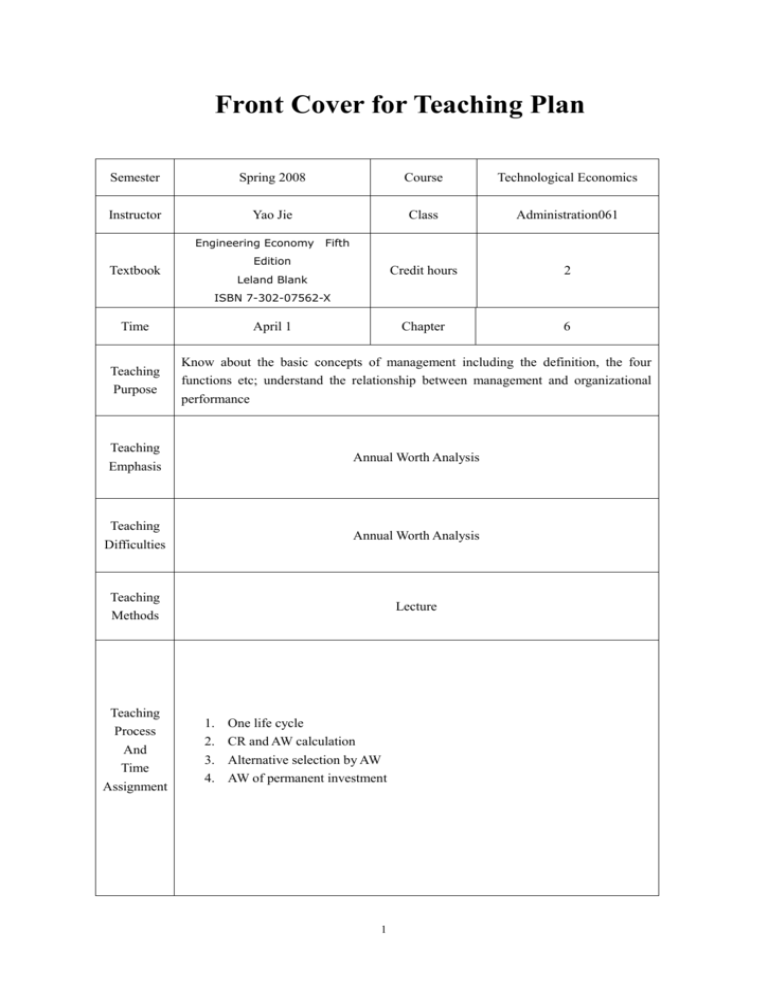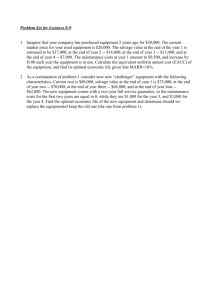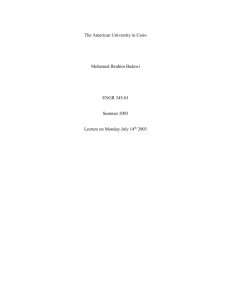
Front Cover for Teaching Plan
Semester
Spring 2008
Course
Technological Economics
Instructor
Yao Jie
Class
Administration061
Credit hours
2
Chapter
6
Engineering Economy
Fifth
Edition
Textbook
Leland Blank
ISBN 7-302-07562-X
Time
April 1
Teaching
Purpose
Know about the basic concepts of management including the definition, the four
functions etc; understand the relationship between management and organizational
performance
Teaching
Emphasis
Annual Worth Analysis
Teaching
Difficulties
Annual Worth Analysis
Teaching
Methods
Lecture
Teaching
Process
And
Time
Assignment
1.
2.
3.
4.
One life cycle
CR and AW calculation
Alternative selection by AW
AW of permanent investment
1
Teaching Plan
Content
Remark
Section 6.1 Advantages and Uses of Annual Worth
Popular analysis technique
Easily understood -- results are reported in $ per time period, usually $ per year
Eliminates the LCM problem associated with the present worth method
Only have to evaluate one life cycle
AW Calculation from PW or FW
Computation from PW or FW
AW = PW(A/P,i%,n) or
AW = FW(A/F,i%,n)
If AW determined for alternative comparison, equal service assumption requires
that
n = LCM number of years
AW converts all cash flows to their end of period equivalent amounts in $ per year
AW Value from Cash Flows
AW values can be calculated directly from cash flows for only one life cycle
Not necessary to consider the LCM of lives as is in PW or FW analysis
For alternative comparison, select the alternative with the best AW value
AW and Repeatability Assumption
If two or more alternatives have unequal life estimates, only evaluate the AW for
one life cycle of each alternative; The annual worth of one cycle is the same as
the annual worth of all future cycles (from repeatability assumption)
Repeatability Assumption:
1. The services provided are needed forever
2. The first cycle of cash flows is repeated for all successive cycles in the same
manner
3. All cash flows will have exactly the same estimated values in every life cycle.
Note: The third assumption may be unrealistic in many problems encountered in
industry
2
One or More Cycles
AW assumes repeatability of cash flows
Cycle 1
Cycle 2
…
Cycle k
Find the annual worth
of any given cycle
($/period)
Annualize any one of the cycles
Slide Sets to accompany Blank & Tarquin, Engineering
Economy, 6th Edition, 2005
6-8
© 2005 by McGraw-Hill, New York, N.Y All Rights Reserved
Ex 6.1 -- 6 Year & 9 Year Alternatives
For PW or FW analysis, need an 18 year study period. Means a lot of calculation
effort!
3 life cycles of the 6 year project
2 life cycles of the 9 year project
Using AW Analysis
If the cash flow patterns are assumed to remain the same for the 6 and 9 year
projects for future cycles, then for AW method
Advantages/Applications of AW:
Applicable to a variety of engineering economy studies such as:
Asset replacement
Breakeven analysis
Make-or-Buy decisions
Studies dealing with manufacturing costs
Economic value added (EVA) analysis
Section 6.2 Calculating Capital Recovery and AW
An economic alternative should have the following cash flow estimates made
Initial investment -- P
Estimated future salvage value -- S
Estimated life -- n
Interest rate -- i% (this is usually the MARR)
Estimated annual operating costs – AOC
Capital Recovery (CR) is the annualized equivalent of the initial investment P and
the future salvage value S for n years at i%
Capital recovery cost
3
It is important to know the equivalent annual cost of owning an asset
This cost is called “Capital Recovery” or CR, CR is determined using {P, S, i, and
n}
Comparing capital recovery with AW
AW = - CR – AOC
where AOC itself is an annual equivalent amount (same each year).
Capital Recovery Calculations
Method 1
Compute equivalent annual cost of the investment P and subtract the equivalent
annual savings of the salvage value S. This is
P(A/P,i,n) - S(A/F,i,n)
Determine CR as the negative (cost) of this relation
CR = -[P(A/P,i,n) - S(A/F,i,n)]
Method 2
Subtract salvage value S from original cost P and calculate the equivalent annual
cost of (P-S)
Add to that the interest which the salvage value would return each year, S(i)
CR = -[(P - S)(A/P,i,n) + S(i)]
Excel can be used to find CR= PMT(i%,n,P,-S)
CR Amount: What It Means
CR is the annual cost associated with owning a productive asset over n time periods
at interest rate i% per period.
Equivalently, CR may be interpreted as the minimum amount of money an
investment must earn each of n years to recover the initial cost at a return of i%.
Example 6.2: P = $12.46 million, S = $0.5 million, n = 8 years, i = 12%, AOC =
$0.9 million per year
CR by method 2:
CR = -[(12.46-0.5)(A/P,12%,8)+ 0.5(0.12)]
= $-2.47 million per year
AW = CR – AOC = - 2.47 - 0.9 = $ - 3.37 million per year
Section 6.3 Evaluating Alternatives Using AW
For mutually exclusive alternatives, select one with lowest AW of costs(service) or
highest AW of net incomes (revenue).
This means, select the numerically largest AW alternative.
If AW < 0 at MARR, the (revenue) alternative is not economically justifiable, since
initial investment P is not recovered over n years at the required rate of MARR
= i% per year.
4
Example 6.4(a):
Alternative A has two components with n values of 8 and 12 years; Alternative B
has n = 24 years
Selection using AW chooses B with the lower equivalent annual costs
Alternative
Lives
CR
AW
A
8 & 12
$-24,424
$-36,724
B
24
$-27,146
$-29,646
Only one life cycle of each asset was considered
PW analysis would require using LCM of 24 years
Example 6.4(b):
Specified study period of only 6 years reduces time to recover investment, so AW
values of costs go up
Alternative Study Period
CR over 6 years
AW over 6 years
A
6
$-26,382
$-38,682
B
6
$-43,386
$-45,886
Now, select A since it has lower AW of costs
Bigger impact on CR for B since recovery time is reduced from 24 to only 6 years
Check out the computer solution for this example
Special Cases for AW Analysis
If cash flow repeatability assumption can’t be made, specify a study period of n
years and perform analysis with this n in all computations (Example 6.4(b) did
this)
If projects are independent, select all with AW > 0 at i = MARR, provided no
budget limit is defined. If budget limited, use techniques of chapter 12
Section 6.4 AW of a Permanent Investment
If an investment has no finite cycle (or a very long estimated life), it is called a
perpetual or permanent investment
If “P” is the present worth of the cost of the investment, then the AW value is P
times i
AW =A = P(i)
AW is actually the amount of interest P would earn each year, forever
Remember: P = A/i
See Examples 6.5 and 6.6 for illustrations
5









